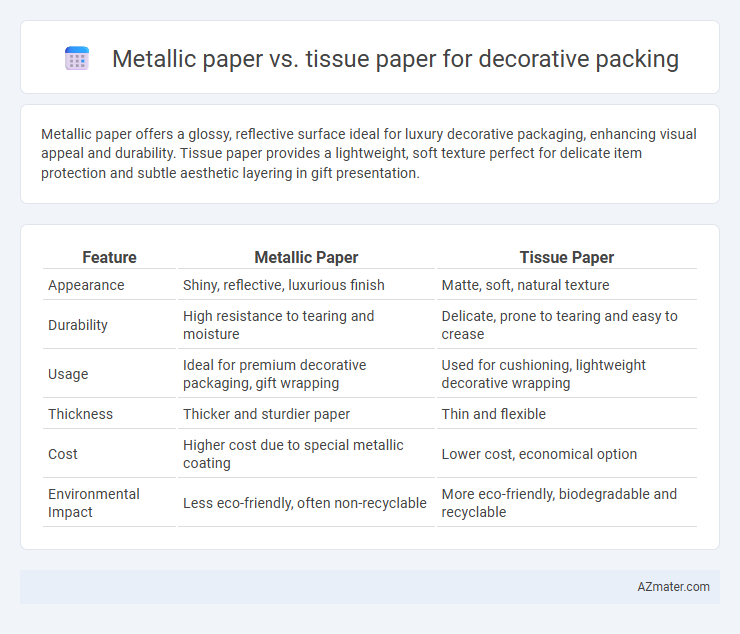Metallic paper offers a glossy, reflective surface ideal for luxury decorative packaging, enhancing visual appeal and durability. Tissue paper provides a lightweight, soft texture perfect for delicate item protection and subtle aesthetic layering in gift presentation.
Table of Comparison
| Feature | Metallic Paper | Tissue Paper |
|---|---|---|
| Appearance | Shiny, reflective, luxurious finish | Matte, soft, natural texture |
| Durability | High resistance to tearing and moisture | Delicate, prone to tearing and easy to crease |
| Usage | Ideal for premium decorative packaging, gift wrapping | Used for cushioning, lightweight decorative wrapping |
| Thickness | Thicker and sturdier paper | Thin and flexible |
| Cost | Higher cost due to special metallic coating | Lower cost, economical option |
| Environmental Impact | Less eco-friendly, often non-recyclable | More eco-friendly, biodegradable and recyclable |
Introduction to Decorative Packing Materials
Metallic paper offers a glossy, reflective surface that enhances the visual appeal and adds a sense of luxury to decorative packing, making it ideal for premium gifts and retail packaging. Tissue paper, known for its lightweight and delicate texture, provides a soft, protective layering that adds elegance without bulk, commonly used for wrapping fragile items or as filler material. Both materials serve distinct purposes in decorative packing, with metallic paper emphasizing aesthetic impact and tissue paper focusing on protection and subtle decoration.
What is Metallic Paper?
Metallic paper is a premium decorative packaging material characterized by a shiny, reflective surface created through a metalized film coating, enhancing visual appeal and luxury perception. Its durability and resistance to moisture make it ideal for gift wrapping, product packaging, and craft applications requiring a sophisticated finish. Unlike tissue paper, which is lightweight and porous, metallic paper offers greater structural support and a striking metallic sheen that elevates the presentation quality.
What is Tissue Paper?
Tissue paper is a lightweight, thin paper commonly used in decorative packing to provide an elegant and delicate touch while protecting fragile items. Unlike metallic paper, which has a glossy, reflective surface that adds sparkle and durability, tissue paper offers softness and flexibility, making it ideal for wrapping, cushioning, and enhancing the visual appeal of gifts. Its porous texture allows for easy folding and layering, making tissue paper a versatile choice for creative packaging designs.
Aesthetic Appeal: Shine vs. Softness
Metallic paper offers a high-gloss, reflective surface that enhances the visual impact of decorative packaging with vibrant, eye-catching shine. Tissue paper provides a delicate, matte finish that introduces softness and elegance, creating a subtle, understated appeal. The choice between metallic and tissue paper depends on whether a bold, luxurious look or a gentle, refined aesthetic is desired for the packaging.
Durability and Strength Comparison
Metallic paper offers superior durability and strength compared to tissue paper, making it ideal for decorative packaging that requires protection and a premium appearance. Its coated surface resists tearing and moisture, ensuring the packaging maintains integrity during handling and transport. In contrast, tissue paper is lightweight and delicate, better suited for gentle wrapping or layering rather than structural support.
Versatility in Decorative Uses
Metallic paper offers high versatility in decorative packing due to its reflective surface and vibrant colors, making it ideal for upscale gift wrapping, party decorations, and branding displays. Tissue paper, prized for its softness and durability, excels in delicate, layered wrapping and as filler material to cushion fragile items while adding texture and depth to packaging. Both materials complement each other, with metallic paper enhancing visual impact and tissue paper providing subtle elegance and structural support in decorative applications.
Cost Differences and Budget Considerations
Metallic paper typically costs more than tissue paper due to its specialized coatings and reflective properties, making it a premium choice for decorative packaging. Tissue paper offers a budget-friendly option with its lightweight, biodegradable nature, ideal for cost-conscious projects without compromising aesthetic appeal. Businesses must evaluate their packaging goals and audience expectations to balance cost efficiency with luxurious presentation effectively.
Eco-Friendliness and Sustainability
Metallic paper, often coated with aluminum, poses challenges for recycling and biodegradability, making it less eco-friendly compared to tissue paper, which is biodegradable and compostable due to its natural fibers. Tissue paper is usually made from recycled materials and supports sustainable packaging by reducing environmental impact and promoting circularity. Choosing tissue paper for decorative packing enhances eco-conscious efforts by minimizing waste and supporting renewable resource cycles.
Ideal Occasions for Each Paper Type
Metallic paper is ideal for luxury gift wrapping and festive occasions such as weddings, anniversaries, and holiday celebrations due to its reflective surface and vibrant colors that add a premium and eye-catching appeal. Tissue paper suits everyday decorative packing, including birthday presents, party favors, and delicate items, thanks to its soft texture and flexibility that protect fragile contents while providing a subtle elegance. For themed events requiring a sophisticated or celebratory touch, metallic paper enhances visual impact, whereas tissue paper offers versatility and softness for casual or protective packaging needs.
Conclusion: Choosing the Right Paper for Decorative Packing
Metallic paper offers a glossy, premium finish ideal for luxury decorative packing, while tissue paper provides a soft, lightweight, and cost-effective option perfect for protecting delicate items. The choice depends on the desired aesthetic, budget, and protection level required; metallic paper suits high-end gifts, whereas tissue paper excels in everyday, eco-friendly packaging. Selecting the right paper enhances the unboxing experience and ensures the presentation aligns with brand values and product needs.

Infographic: Metallic paper vs Tissue paper for Decorative packing
 azmater.com
azmater.com